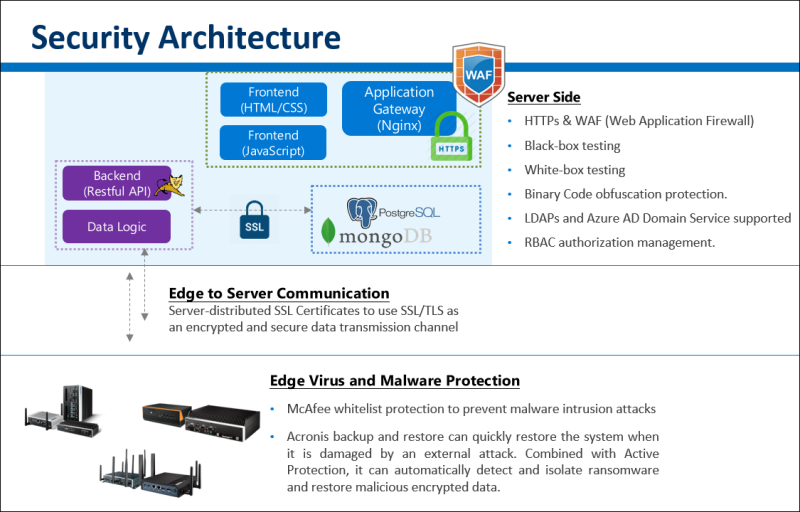DeviceOn/ePaper Overview
Contents
What’s DeviceOn/ePaper?
Feature Highlight
Security
System Security is about not only installing and onboarding devices and networks securely but also managing their ongoing operations throughout their lifecycle and identifying and isolating any threats. Industries everywhere are digitizing, which is creating a multitude of new security requirements for the Internet of Things (IoT). End-to-end (E2E) security management will be essential to ensuring security and privacy in the IoT, while simultaneously building strong identities and maintaining trust. As the diversity of IoT services and the number of connected devices continue to increase, the threats to IoT systems are changing and growing even faster.
A comprehensive model of IoT device security, as shown in below structure, the comprehensive IoT module security in an IoT system has three main parts:
1. Device Security
DeviceOn leverage McAfee Embedded Security software to prevents unauthorized changes and will lock a system down to a known application is an industry, that’s an industrial first solution to secure embedded devices. For disaster recovery, Acronis provides users a quick and easy-operated solution to protect data and recover the entire system even when OS crash, effectively reduces down-time cost and lowers the risk of data loss.
2. Secure Transporty
The server distributed SSL certificates to use TLS (v-1.3) as an encrypted and secure data transmission channel, and device default enable MQTT-SSL for communication.
- Topics Isolation & Unique Device IoT Key
- Topics are specially handled in RabbitMQ. Topics are not public. Access control isolates an activated device to publishing/subscribing only to that device’s topics even though multiple devices will have subscriptions to identically named topics. A device is not allowed to subscribe/publish to another device’s topics.
- Second, in IoT applications, command topics are used to control a device remotely and to acknowledge successful command executions. Unlike telemetry, command topics are not read-only. Commands are a back and forth workflow that can occur between the cloud and devices. Because commands are actionable messages, isolate the MQTT topic for command messages from telemetry topics.
- Use x.509 Certificates to Authenticate Edge Device
- DeviceOn supports x.509 certificate authentication for use with a secure TLS/SSL connection. The x.509 edge device authentication allows device to authenticate to servers with certificates rather than with a username and password.
- Use TPM + x.509 Certificates to Provide Higher Security
- The solution that we integrate on DeviceOn for Azure (Enterprise Edition), leverage Azure IoT Edge and TPM 2.0 to offer secure authentication and private key protected.
- TPM, also known as ISO/IEC 11889, is a standard for securely generating and storing cryptographic keys. TPM also refers to a virtual or physical I/O device that interacts with modules that implement the standard. A TPM device can exist as discrete hardware, integrated hardware, a firmware-based module, or a software-based module.
3. Secure Cloud Service
The cloud service components include Tomcat as a web server that provide an HTTPS protocol and backend APIs services, each connection between backend and database adopt SSL encryption, and enforce password policies. Second, for advanced attack, such as SQL injection, XXC, local and remote file vulnerabilities, the Nginx+Naxsi to achieve Web Application firewall (WAF) protection. All DeviceOn services pass through famous vulnerability tools to ensure security for your it IoT solutions, and the binary uses ProGuard code obfuscation protection. The APIs authentication not only uses JWT (JSON Web Tokens) to hide/encrypt sensitive data, but, integrate LDAPs & Azure AD Domain Service for secure.

Role-based Access Control (RBAC)
| 列1標題 | 列2標題 |
|---|---|
| 行1列1內容 | 行1列2內容 |
| 行2列1內容 | 行2列2內容 |